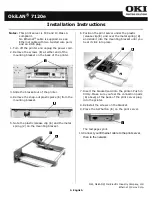Scalability and Clustering
379
Titan SiliconServer
4.
At the prompt run ‘
service
quorumdev
’ with the appropriate option, i.e.
start
,
stop
,
status
,
unconfigure
or
restart
.
[1-8]:
If specified, the command works on the appropriate
instance
of the quorum device.
❑
start
: starts any QD process not currently running.
❑
stop [1-8]
: stops the quorumdev process.
❑
restart [1-8]
: stops and then starts the quorumdev process.
❑
unconfigure [1-8]
: removes the current cluster configuration settings, so that the
quorum device can be assigned to a new cluster or the same cluster following an
error. After unconfiguring, the quorum device has to be restarted.
❑
status [1-8]
: reports the quorum devices current status, e.g. quorumdev is
running, quorumdev process not running. If the QD is owned by a cluster,
additional information about the cluster is also visible such as the cluster name
and unique ID.
Caution:
Incorrect usage of the stop, restart, or unconfigure options may
disrupt QD services provided to clusters throughout a Server Farm.
Cluster Name Space
When deployed on a Titan SiliconServer, the Cluster Name Space (CNS) allows separate and
physically discrete file systems to appear as a single logical file system, i.e. a unified file system.
This virtualizes multiple storage elements, allowing network clients to access them through a
single CIFS share or NFS export.
Like a file system, at the top of the CNS tree is a root directory. Subdirectories can then be
created under the root directory. The root directory and subdirectories in the CNS tree are
virtual directories. Access to these virtual directories is read-only. Only Titan’s physical file
systems support read-write access. Physical file systems can be made accessible under any
directory in the CNS tree by creating a File System Link. File System Links associate the virtual
directory in the CNS tree with physical file systems.
Any directory in the CNS can be exported or shared, making the CNS, and the underlying
physical file systems, accessible for use by network clients. The creation and configuration of
the CNS can be done either through the Web UI (described below) or the CLI.
Once shared or exported, the CNS will be accessible through any EVS in the server or cluster.
As a result, it is not necessary to access a file system through the IP address of the specific EVS
to which the file system is associated. Consequently, file systems linked into the CNS can be
relocated between the EVS on the server or cluster transparently and without requiring the
client to update its network configuration. This can be useful to help distribute load between
servers in a cluster, allowing heavily used file systems to be relocated to servers that are better
able to support the load.
The typical configuration for CNS is also the most simple. After the root directory of the CNS has


















